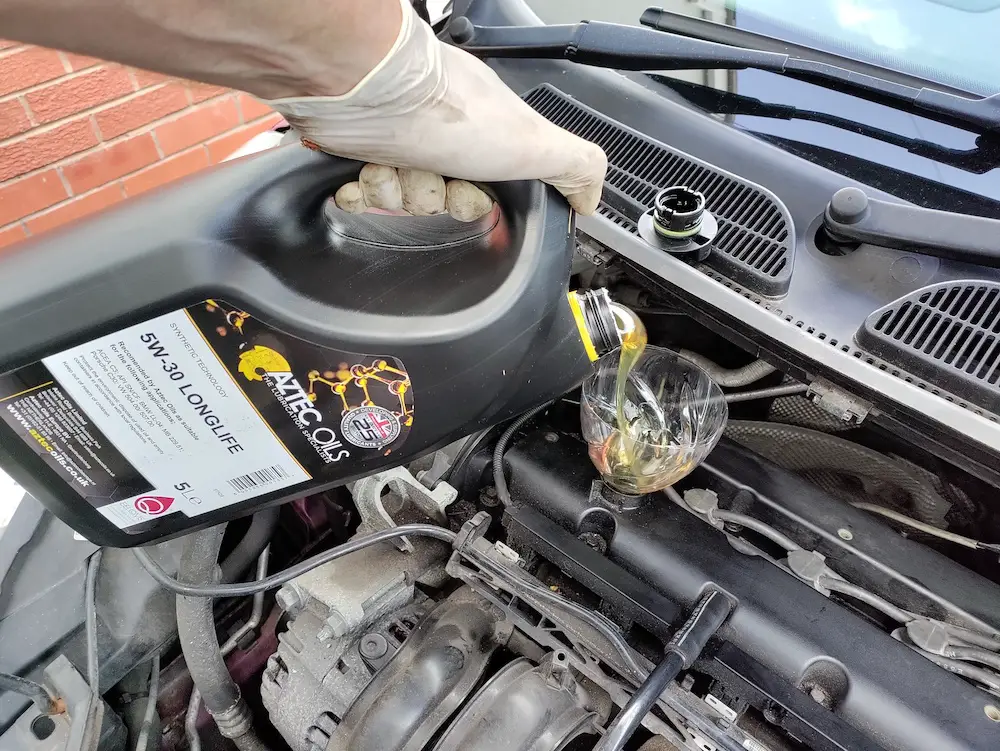The cost of an oil change can vary depending on your engine’s size and what type of oil it needs.
You should expect to pay between $50 and $75 for a synthetic oil change.
This article will explain what an oil change is and how the cost is made up. How much you’ll pay will vary from situation to situation. Still, this article should give you the necessary understanding of whether or not the cost is worth it.
- What motor oil does
- Oil change – what happens?
- Oil change cost
- DIY oil change cost
- Why oil needs changing
- How to change the oil
- Different types of engine oil
- Oil change costs in the UK
- FAQs
What Does Oil Do In A Car
Engine oil, or motor oil, sits in a metal container in your engine called the sump. When the car’s running, the oil pump forces the oil through a series of pipes and channels in the engine. It flows past the engine’s moving parts, reducing friction and removing heat.
Modern oils are also filled with additives. These additives help to prevent rust and sludge buildup, keeping the engine in good condition.
The most common problem within the oil system is either a leak or a blown head gasket. Follow the links to read up on those topics in more detail.
Most modern engine oils are “multigrade” oils. At different temperatures, they behave differently. For example, 5W30 has a relative viscosity (“thickness”) of 5 when in cold (“Winter”) conditions and a relative viscosity of 30 under normal operating conditions.
For example, look at how the behavior of 10W20 compares so SAE 10 and SAE 20.
With proper regular maintenance, some high-quality engine oil will keep your car’s engine last for a very long time. In most newer cars, you’ll only have to change it every 10,000 miles or so.
What Is An Oil Change
When you take your car into the services for an oil change, the technicians will… well, change the oil. They should also change the oil filter at the same time. Most companies also include optional extra services, such as a car wash, vacuuming out the interior, or topping up the other fluids. Walmart is a good example of this – follow the link above or click here to read about an oil change at Walmart.
I’ll go into it in greater detail later in this article, but, in short, the technician will get underneath the car, usually by raising the vehicle on a four-post or two-post ramp. They’ll open the sump plug and allow the motor oil to drain out. Once most oil is sitting in the oil pan rather than the sump, they’ll remove and replace the oil filter. Next, they’ll replace the sump plug and pour the correct quantity of oil back in through the cap on the top of the engine.
Oil changes are pretty simple jobs, hence their comparatively low cost.
How Much Does An Oil Change Cost
In the US, the cost of an oil change will vary with the type of oil used and the quantity needed.
Keep on scrolling down to learn more about the different types of motor oil.
At its cheapest, a standard oil service with conventional oil could be as low as $20 (see Walmart’s official prices). At the other end of the spectrum, Walmart charges about $50 for a fully synthetic oil change.
Fully synthetic oil changes may cost more than this if you have a larger-than-average engine or it requires a specialist grade.
Therefore, a reasonable estimate for an oil change is likely to be between $50 and $100.
I would always, always recommend paying the extra amount to get fully synthetic oil if you have a vested interest in your car. As most of us probably do.
Oil Change Cost
Unlike with many things that need doing, shops tend to have fixed rates for their regular service jobs. Unless you have a very particular engine, you’ll probably pay the same amount whether you drive a Smart or a Mustang.
Where I used to work, how much the customer paid depended on their engine size and the car’s age, but it didn’t vary too much.
In general, a garage will decide on the price for an oil change service based on the average labor time and oil quantity used for a service, so this is technically what you’re paying for.
Is It Cheaper To Change Your Own Oil
In most situations, it would cost less to change your oil in a DIY job. Sometimes, though, it costs a consumer much more to buy oil off the shelf than it would an auto business. This difference can be so significant that you may as well just take your car to a professional anyway. This is more often the case here in the UK, where fully synthetic oils from the shops tend to cost over $13 per liter, compared to $5 to $7 per liter in the US.
The main downside of changing your oil in a DIY job, rather than getting it done by a technician, is you can’t stamp your service book – there’s no valid service history when you come to sell the car. As such, it could lower the final value of your vehicle. Whether or not you take that risk is, of course, up to you.
It would also be worth considering the fact that the work won’t be insured if you do it yourself. Writing a little warranty note and handing it to yourself doesn’t count, sadly. If – in the unlikely but still possible – situation where you do something wrong and cause damage to the car, there’s nothing to protect it. You’ll have no choice other than to pay out to fix the damage or scrap the vehicle.
However, you’ll usually pay less for a DIY oil change regarding the raw initial cost. To purchase an oil filter and fully synthetic oil, you should expect to pay between $30 and $50. As such, you can expect savings of about $25 to $30 by doing it yourself.
Depending on how long this job takes you, that may or may not be worth it.
Why Do Cars Need Oil Changes
Over time, oil breaks down. It doesn’t last forever. Sludge forms within the channels and the sump, and you end up with oil that doesn’t really work anymore.
The oil’s job is to lubricate the moving parts. It puts a barrier between metal components, reducing friction and removing heat, keeping everything flowing along smoothly.
As time goes on, the oil degrades. Although relatively recent technological advances mean that the oil lasts longer and cleans your engine through as it flows (such as fully synthetic motor oil), it will inevitably need to be changed eventually.
The main disadvantage of multigrade oil is that it doesn’t stay multigrade forever. To get multigrade oil, VIIs (Viscosity Index Improvers) are added to the oil by the manufacturer. They cause the oil to behave differently at different temperatures and are basically molecular-sized slinkies. Eventually, the engine’s movements will literally chop up these particles, meaning the oil is no longer multigrade.
Once that’s happened, you’ll need to change the oil. Without removing the oil, there’s no practical way of telling whether any of this has happened. Instead, manufacturers recommend changing the oil every few thousand miles (usually between 7,500 and 12,500).
Changing the oil at regular intervals ensures you don’t end up with a poorly functioning motor oil. This would result in a damaged engine, which is both dangerous and costly. That’s why it’s so important to change the engine oil when necessary.
How To Do Oil Change
In this section, I’ll run through a quick guide on how to change your oil. Please take this as advice only and don’t attempt an oil change without an experienced person on hand. Although it’s one of the more straightforward tasks on a car, it can occasionally go wrong.
How Much Does An Oil Change Cost DIY – What You’ll Need:
- The correct quantity of the recommended oil (for example, 4.5 quarts of 5W30). You can find this information in your owner’s manual. You’ll also need a funnel.
- A new oil filter.
- A socket + ratchet (+ extension), wrench, or Allen key to remove the sump plug (correctly sized).
- An oil pan to catch the waste oil you’re removing from the car.
- A torque wrench.
- PPE: the most important PPE here would be latex gloves and coveralls to protect your skin or clothing. Motor oil is an irritant and causes some people lifelong skin conditions such as eczema. You may also like to consider goggles to protect your eyes, a hard hat if you hit your head, and steel toe-capped boots.
- Rags, parts cleaner, and granules (if you can get them) to clean up spillages.
- You may need a trolley jack and axle stands if your car is particularly low to the ground.
You’ll also need to be in a safe, flat environment. Ideally, you should use a ramp if possible, but for most of us, those aren’t available.
The car needs to be flat to allow the oil to drain out properly. If it’s slanted, some oil will get stuck in the corner of the sump and therefore not come out.
Then the car needs to be safe. You’ll be working underneath it, so it’s imperative that it doesn’t fall on you or run over you. Take extra precautions to make sure this is the case and, if you’re in any doubt, it’s best to take the car somewhere else before getting started. Once the oil’s out, you won’t be able to drive the vehicle.
Before you start, you should also have some way of disposing of the oil. It’s illegal to dispose of motor oil down drains and can lead to HUGE fines. So don’t do that. You’ll probably either have to call someone up, take it to the local tip, or ask a friendly mechanic if they might get rid of it for you.
How Much Does An Oil Change Cost DIY – Step By Step
- Before starting, make sure you’ve got everything ready. Park the car in a safe, flat space and – only if absolutely necessary – jack it up, putting axle stands in. For most cars, you’ll not need to do this. Switch the engine off and remove the key so that nobody starts the engine while you’re underneath the car and it has no oil in it.
- Open the oil cap on the top of the engine. This allows air through and encourages the oil to drain properly.
- Take the oil pan and place it underneath the sump. Use the necessary tool to remove the sump plug and drain the oil into the pan. Be careful not to spill any or get any oil on yourself. The sump plug can shoot out without warning as you’re removing it, so be aware of that. Watch out if the plug is on the side of the engine, as the oil will flow out with a lot of pressure.
- Keep an eye on the oil as it drains because as the pressure within the sump decreases as the oil leaves, the flow rate will also decrease. If you take your eye off it, you might end up with a big puddle of oil under your car in no time.
- When the oil has almost all drained (there might still be the occasional drip), replace the sump plug. Use the torque wrench to tighten it to the exact amount that the owner’s manual specifies. This is very important. Over-tightening the sump plug could strip the thread off, meaning the hole will need re-threading and possibly even a new sump. Under-tightening could lead to an oil leak.
- Get out from under the car and use the funnel to pour the correct quantity of the new engine oil through the open oil cap.
- Use the engine oil dipstick to measure how much oil is in the car. As long as it’s between the minimum and maximum marks, we’re in business, and you’re good to go.
- Lower the car if it’s in the air.
- Switch on the engine. At first, it’ll sound awful. That’s because there’s no oil all around the engine. As the oil pump kicks in, the oil will begin to flow, and the sound should dissipate after no more than ten seconds or so. If it persists, turn the engine on and call for assistance.
- As long as everything’s good, you’re all set!
Types Of Oil Changes
As mentioned previously, you can get a few different types of oil in the US.
- Conventional – conventional motor oil costs the least. It’s no more than refined crude oil with a few extra additives in it. While it’s not necessarily bad for your engine – it’ll still lubricate it just fine – conventional oils tend to be less effective than the other types you can get. They also don’t protect your engine in the same way.
- Semi-synthetic – semi-synthetic motor oil is somewhere in between conventional and fully synthetic, as the name suggests. It’s pretty much exactly what it is – somewhere in the middle – a bit like the politician that doesn’t want to get too involved. It’s better than conventional but not as good as fully synthetic. Likewise, it’s cheaper than fully synthetic but more expensive than conventional. That’s not a bad thing. If you’re on a bit of a budget but still want to look after your car as much as possible, semi-synthetic is probably the way to go.
- Fully synthetic – this type of oil is made in a lab under stringent conditions. The result is very high-quality oil, one which you should expect to last for as long as possible and be very good for your engine. It’ll also be very good at protecting your engine, keeping sludge and rust away. The cost for this? It’s a literal cost; fully synthetic oil might cost more than double the same amount as conventional.
- High-mileage – high-mileage oil contains a unique selection of additives. “High-mileage” refers to the total number of miles on the odometer rather than the idea of long trips (necessarily). The motor oil’s primary purpose is to work to protect engine seals, preventing oil burn-off. The longer the seals are kept in good condition, the longer the car’s engine will last. Your mechanic will probably recommend high-mileage oil if your vehicle has covered over 75,000 miles.
Here’s Engineering Explained to take you through conventional vs fully synthetic oil.
How Much Does An Oil Change Cost In The UK
Compared to the US, prices here in the UK, where our home base is, just for some context and comparisons, are high. An oil change can cost anywhere from $65 to $155, with the average being a little under $130.
So why does an oil change cost more here than in the States?
To take a very simplistic viewpoint, the average oil is of a higher quality. That’s not to say it’s always a good thing – it makes owning a car considerably more costly and therefore difficult for the average person, for example.
Although we’re no longer a part of the EU, Britain has been part of the Union for 47 years. The same regulations applied across the continent also applied to us on our island. EU regulations – from what I can see, at least – tend to be stricter than those I’ve seen in the States, especially when it comes to environmental issues.
- There are stricter carbon emissions laws (CO and CO2) in the EU. SAPS – sulfated ash, phosphorus, and sulfur – comes from engine oil and can negatively affect emissions-controlling devices such as DPFs (Diesel Particulate Filters). The oil in the EU is, therefore, made with lower SAPS levels.
- At least historically, we don’t change our oil as often as Americans, apparently. We expect our oil to last longer. Perhaps that’s a cyclical argument to do with the higher cost.
- The wide array of different weather patterns we experience means that the oil has to cope with many different situations and climates, hence the almost unanimous use of multigrade oils.
- Different manufacturers have different recommendations for what types of oil to use. With newer cars, you’ll often have to use the OEM-recommended oil to avoid invalidating the warranty. These oils are also optimal for the individual vehicle, it must be said.
Another factor to consider – although I haven’t found any definitive sources to prove or disprove this – is the vast difference in oil production. Most of the oil found around here comes from offshore oil rigs in the North Sea; most of the oil we use is imported from Norway.
The UK produces about 1,000,000 barrels of oil per day. Over the last few years, the US has averaged approximately 11,000,000 barrels of oil per day (gathered from a quick look at this graph).
It’s clear from this that one might expect oil-based products to be cheaper in the US than in the UK.
What’s The Best Option
An oil change shouldn’t cost too much, either way. As we’ve looked at in earlier sections of this article, there are pros and cons to both arguments.
If you’re confident enough and you’re driving a relatively old car, it’s probably worth changing the oil yourself. That’ll minimize your cost at the time.
Otherwise, feel free to take your vehicle to the nearest mechanic that you trust. As mentioned before, companies such as Walmart offer this service (with mixed opinions as to the quality).
Overall, an oil change is likely to cost you somewhere between $30 and $100, depending on a few factors.
Oil Change Facts:
- Regularly getting your car’s oil changed is important to maintain its health and prevent future issues.
- Oil changes can cost anywhere from $20 to $100 at a lube shop, with price variations based on car make and model, type of oil used, and location.
- Many chain shops offer coupons and deals to help reduce the cost of an oil change, and it’s worth looking for these before going in.
- The biggest factor in the final price of an oil change is the type and quality of oil used, and the recommended type of oil can be found in the car’s owner’s manual.
- While newer cars may require synthetic oil, some vehicles can use conventional oil instead. However, using a lower-quality oil than specified could void the car’s warranty.
- Dealerships can offer competitive pricing for oil changes, particularly for more specialized vehicles, but may also charge a premium due to higher labor costs or the use of special oil brands.
- Mechanics may use oil changes as an opportunity to sell additional services, so consulting the owner’s manual and knowing the car’s maintenance history can help avoid unnecessary upsells.
- The outdated “3,000-mile rule” for oil changes is not accurate for all vehicles, and the owner’s manual should be consulted for the correct maintenance schedule.
- Full synthetic oil has more additives to protect the car’s engine, and while it may cost more than conventional oil, it could result in less engine wear over the life of the vehicle.
- Car owners with warranties or service plans should check if maintenance is included and if it makes sense to go to a dealership for oil changes.
FAQs On How Much Does An Oil Change Cost
If you’re still curious to learn more about how much does an oil change cost, our FAQs here might help…
How Long Do Oil Changes Take
Oil changes are among the simplest and fastest servicing items that you can perform on a car. Hence, why you don’t have to worry too much about how much does an oil change cost, as labor rates even among the priciest of workshops won’t cost you that much in this instance. Oil changes regularly take as little as just 15 minutes to completely drain out the old oil and replace it with a new bottle, or up to 45 minutes at the longest. If you’re doing an oil change yourself, the time taken will vary depending on your skills and experience. If you’re not used to doing oil changes yourself, it might take an hour or more. But once you get used to it, sub-30-minute oil changes will be a routine.
How Much Oil Does My Car Need
The amount of oil required in a car will vary depending on how large the engine is. As a general rule of thumb, 4-cylinder engines will take in around 4 to 5 quarts of oil. Meanwhile, a 6-cylinder engine would need about 5 to 6 quarts. On the other hand, a large V8 could require between 5 to 9 quarts of oil. For most of you out there, around 4 to 6 quarts are the likeliest amount. If you want to be more certain, you could always refer to your car’s owner’s manual. It would not only specify the right type and brand of motor oil to use. But, it would also contain information on just how many quarts of oil your car’s going to need. Just remember that adding too little or too much oil is never a good thing.
How Often Should You Get Your Oil Changed
To be absolutely sure, you should always refer to your car’s owner’s manual to understand just how often an oil change would be required. There, you’ll find the specifics, as well as details on what type or brand of oil to use. In general, most newer vehicles you see today would only need an oil change every 10,000 miles or so. Although, automakers recommend an oil change every 7,500 to 12,500 miles, just to be safe. However, know that the frequency of oil changes can vary wildly depending on what type of oil you use. A bottle of conventional oil would last a shorter period (sometimes as little as 3,000 miles) before it needs replacing compared to a synthetic or semi-synthetic oil mixture.
What Happens If You Don’t Get An Oil Change
Going without an oil change for too long is a bad idea. Once the motor oil breaks down, it could no longer lubricate or cool your engine’s insides as efficiently as it did before. Furthermore, there’s a growing risk that your oil turns into a viscous sludge. Once again, a sludge-like engine oil can’t pull in heat or act well as a lubricant. This would lead to your engine overheating or even blowing a gasket. Worst comes to worst, your engine’s internal components would start grinding against each other, and sooner rather than later, the entire engine seizes up and fails. A seized-up engine is more often replaced entirely rather than rebuilt or repaired, which will be costly.
What Does Oil Do In A Car
Motor oil has two key functions in a car. Mainly, it acts as a lubricant. As oil circulates throughout your engine, it leaves behind a thin, slick film of lubricant on and around the innards of your car’s engine. Thus, allowing metal components to interact with one another smoothly and without the risk of having them grind and wear each other down. A lack of friction means that your engine’s service life has been extended, not to mention ensuring top-notch performance. Furthermore, oil also acts somewhat like a coolant. As it flows within an engine and interacts with its many parts, motor oil is able to pull heat away from those hot components. Hence, helping a bit when it comes to keeping an engine cooled.




